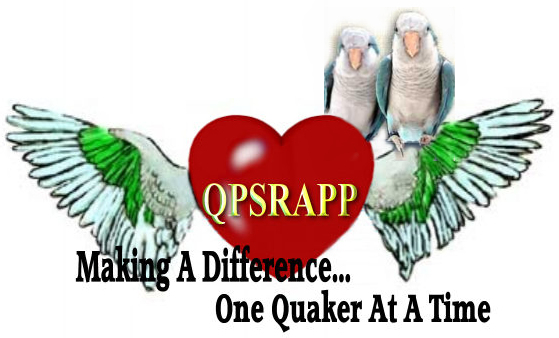QUICK PICK MENU
WHAT TO EXPECT WHEN A QUAKER IS FIRST COLLARED The RAPP Information On Plucking & Foam Collaring Articles are now available for download and printout in their entirety. Click here forWORD file. Click here for PDF file.

At QPSRAPP, we reap the rewards associated with placing Quaker Parakeets into the homes of adopting volunteers. "RAPP birds" come to us for a variety of reasons. Many transfer into their new homes easily. Others come to their new homes with behavioral problems. Of the more prevalent problems, feather picking, (also called plucking), and /or mutilation, are the most frustrating concerns and difficult behaviors to modify.
It is has been said that 1 out of every 10 Quakers will pluck at some point in their life for an undeterminable length of time. The question of why Quakers begin to pluck and /or mutilate and how to break the cycle, is difficult to answer. Plucking can begin for many reasons, individual as each bird. In the case of birds that have experienced moving from one home to another, it would be easy to say that the previous environment in which the bird was living began the behavior. It is not that simple. There is also not one solution or deterrent. So, while you might be one of the fortunate people who does not own a Quaker who feather picks or mutilates, as an owner, you want to be armed with as much information as possible about the behavior, without alarming yourself but, to be as thoroughly educated as you would wish to be about other aspects of Quaker ownership.
RAPP feels the need and responsibility to offer support to each adopting QPSRAPP volunteer about plucking and/or mutilation, especially those volunteers who have elected to adopt Quakers who may have come to them with this behavior already established. It cannot be stressed enough that a complete check up by your veterinarian is the beginning step to addressing the problem and that continuing open and honest communication with your vet is essential. Investigate, discuss, and understand all the options that your vet puts before you. Understand that there are numerous options available and that some experimentation might be necessary before a method is found to be the most effective for treating your bird.
On the following RAPP Support pages are 2 excellent articles that address the use of foam collars. Foam collars have been shown effective in deterring plucking and /or mutilation in many small birds, but not in all. Some vets prefer small plastic collars. The success of each depends largely on the individual bird. Both the plastic and foam collars seem to be more effective and certainly, more comfortable, then the large Elizabethan style collars used on larger birds.
With any type of collar or medication, careful observation of the bird is mandatory. The reaction to medication and to collaring can manifest itself in anger, depression, loss of balance and lack of appetite in the bird. These conditions are temporary, but may last longer in some birds then others. Keep in mind that the emotional reactions you might exhibit may be felt and reflected in the attitude of the bird as the bird adjusts to collaring. While collared, a bird may lack the ability to defend themselves from other animals in the household; cats, dogs, and even, other birds, no matter the loving relationship exhibited prior to collaring, as the collar may be viewed as a foreign object and as a sign of weakness or illness. It is a crucial time to draw upon common sense to make the adjustment to the collar easy and effective.